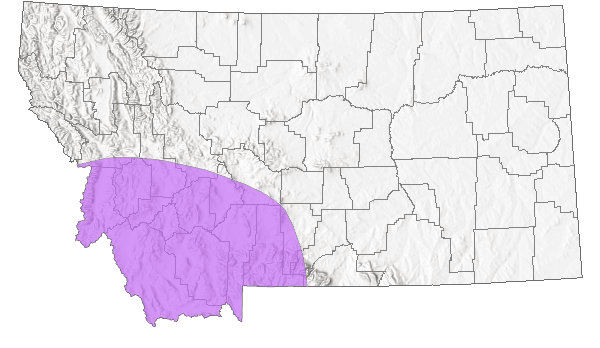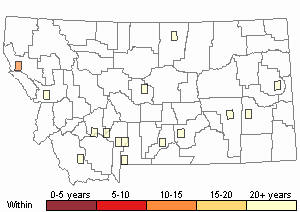View in other NatureServe Network Field Guides
NatureServe
Montana
Utah
Wyoming
Idaho
Wisconsin
British Columbia
South Carolina
Yukon
California
New York
Pallid-winged Grasshopper - Trimerotropis pallidipennis
General Description
The following is taken from Hebard (1928), Brooks (1958), Helfer (1971), Capinera and Sechrist (1982), Vickery and Kevan (1985), Pfadt (2002), Capinera et al. (2004), Brust et al. (2008), and Scott (2010). The general body color is tan or gray, the side of the face is often lighter below the eyes. The tegmina (forewing) has two distinct dark bands across its entire width, with dark spotting at the apex. The median carina (ridge) of the pronotum (thorax) has two sulci (grooves) with lobes anteriorly and low but distinct posteriorly. The hindwing disk varies from whitish to pale yellow with a thin black band, extending along the posterior border, and a thick spur extending about half-way to the base. The apex is translucent. The inner face of the hind femur is pale yellow, with a black medial area, black ring, and knee. The hind tibia is yellow.
Communicative behavior/Crepitation*
Males perform crepitation flights consisting of a series of bursts, each composed of 3-6 snaps. Females do not crepitate. When flushed, they fly swiftly, about 2-3 feet above the ground, often flying up 100 feet to beyond sight. During courtship, males stridulate*, producing a trilling sound; produced by 2-14 strokes with a single femur. Femur-tipping and shaking are used during courtship and male-to-male aggression encounters, often accompanied by striking the ground with the hind tibia (Otte 1984, Vickery and Kevan 1985, and Pfadt 2002).
*Crepitation is the sound produced by grasshoppers making a clicking or snapping noise with their wings when in flight, during courtship, territorial encounters or being disturbed.
*Stridulation is rubbing one body part against another, usually the hind femur against the forewing in the case of the Band-winged Grasshoppers. This is often used for attracting a female during courtship (Otte 1970).
Phenology
The Pallid-winged Grasshopper overwinters in the egg stage. Nymphs begin appearing in late April. Adults generally occur from early June to October. This species is known to make dispersal and migratory flights to other areas and regions, some of them quite distant. It has been reported to occur mostly in June and July. Such flights can affect “phenological dates of occurrence,” for example populations further south attain adult status earlier than those in Montana, thus some early adult occurrences observed here may be dispersing migrants (Capinera and Sechrist 1982, Otte 1984, and Pfadt 2002).
Diagnostic Characteristics
The following comes from Hebard (1928), Brooks (1958), Helfer (1971, Capinera and Sechrist (1982), Vickery and Kevan (1985), Pfadt (2002), Capinera et al. (2004), Brust et al. (2008), and Scott (2010). The body length to tip of forewings is 25-35 mm for males, and 30-45 mm for females.
This species can be visually confused with several Montana
Trimerotropis species having distinct forewing bands, especially
Geyser Grasshopper (
T. diversellus) (Scott 2010).
Species Range
Montana Range
Range Descriptions

 Native
Native
Range Comments
This species is the most widely distributed band-winged grasshopper in the New World. It ranges from southwestern British Columbia, southward through Mexico. (It is not found in Central America but occurs in Argentina). From west to east, through the Pacific Coast states and Baha California, to southwestern Montana, Wyoming, Nebraska, to Texas. In Montana, it has been reported for 4 southwestern counties and seems to be restricted to that region of the state (Otte 1984, Vickery and Kevan 1985, Pfadt 2002, Capinera et al. 2004, and Scott 2010).
Observations in Montana Natural Heritage Program Database
Number of Observations: 18
(Click on the following maps and charts to see full sized version)
Map Help and Descriptions
Relative Density

Recency



 (Observations spanning multiple months or years are excluded from time charts)
(Observations spanning multiple months or years are excluded from time charts)
Habitat
In Montana, the Pallid-winged Grasshopper inhabits dry areas with sparse vegetation, along roadsides, fields and almost any area with a preponderance of bare ground. It can even be found in weedy vacant city lots (Otte 1984, Vickery and Kevan 1985, and Pfadt 2002).
Food Habits
This species is a mixed feeder and consumes a wide variety of grasses and forbs including
Cheatgrass (
Bromus tectorum), needle grama,
Crested Wheatgrass (
Agropyron cristatum), milkvetch, salsify, big sagebrush, rabbitbrush, hoary aster. Plus, arthropod body parts, fungi, and pollen (Pfadt 2002).
Reproductive Characteristics
Courting males stridulate as they move toward a receptive female which remains still as he approaches, mounts, attaches his genitalia and copulates. In one lab study, a single female laid 27 pods containing 955 eggs. The pods are laid in bare soil to a depth of about one inch. The pod is slightly curved, narrow, 1 inch long by 0.1 inch in diameter and contains an average of 34 pale yellow eggs <5mm long. Upon hatching, the nymphs pass through 5-6 instars (Pfadt 2002).
Stewardship Responsibility
References
- Literature Cited AboveLegend:
 View Online Publication
View Online Publication Brooks, A.R. 1958. Acridoidea of Southern Alberta, Saskatchewan, and Manitoba (Orthoptera). The Canadian Entomologist (Supplement 9) 90:5-92.
Brooks, A.R. 1958. Acridoidea of Southern Alberta, Saskatchewan, and Manitoba (Orthoptera). The Canadian Entomologist (Supplement 9) 90:5-92. Brust, M.L, W.W. Hoback, and R.J. Wright. 2008. The Grasshoppers of Nebraska. Lincoln, NB: University of Nebraska Extension Service, APHIS.
Brust, M.L, W.W. Hoback, and R.J. Wright. 2008. The Grasshoppers of Nebraska. Lincoln, NB: University of Nebraska Extension Service, APHIS. Capinera, J.L. and T.S. Sechrist. 1982. Grasshoppers of Colorado: Identification, Biology, and Management. Fort Collins, CO: Colorado State University Experiment Station, Bulletin 584S. 161 p.
Capinera, J.L. and T.S. Sechrist. 1982. Grasshoppers of Colorado: Identification, Biology, and Management. Fort Collins, CO: Colorado State University Experiment Station, Bulletin 584S. 161 p. Capinera, J.L., R.D. Scott, and T.J. Walker. 2004. Field Guide to Grasshoppers, Katydids, and Crickets of the United States. Ithaca, NY. Cornell University Press.
Capinera, J.L., R.D. Scott, and T.J. Walker. 2004. Field Guide to Grasshoppers, Katydids, and Crickets of the United States. Ithaca, NY. Cornell University Press. Hebard, M. 1928. The Orthoptera of Montana. Proceedings of the Academy of Natural Sciences of Philadelphia, Vol. 80:211-306.
Hebard, M. 1928. The Orthoptera of Montana. Proceedings of the Academy of Natural Sciences of Philadelphia, Vol. 80:211-306. Helfer, J.R. 1971. How to Know the Grasshoppers, Crickets, Cockroaches, and Their Allies. Revised edition (out of print), Mineola, NY: Dover Publications.
Helfer, J.R. 1971. How to Know the Grasshoppers, Crickets, Cockroaches, and Their Allies. Revised edition (out of print), Mineola, NY: Dover Publications. Otte, Daniel. 1984. The North American Grasshoppers Volume II. Acrididae (Oedipodinae). Harvard University Press. 366 pp.
Otte, Daniel. 1984. The North American Grasshoppers Volume II. Acrididae (Oedipodinae). Harvard University Press. 366 pp. Pfadt, R.E. 2002. Field Guide to Common Western Grasshoppers, 3rd edition. Laramie, WY: Wyoming Agricultural Experiment Station, Bulletin 912, modified by S. Schell and S. Schell for electronic publication. Accessed 19 February 2020. http://www.uwyo.edu/entomology/grasshoppers/field-guide/index.html#fieldguidetoc
Pfadt, R.E. 2002. Field Guide to Common Western Grasshoppers, 3rd edition. Laramie, WY: Wyoming Agricultural Experiment Station, Bulletin 912, modified by S. Schell and S. Schell for electronic publication. Accessed 19 February 2020. http://www.uwyo.edu/entomology/grasshoppers/field-guide/index.html#fieldguidetoc Scott, R.D. 2010. Montana Grasshoppers, Katydids, and Crickets A Pictorial Field Guide to the Orthoptera. MagpieMTGraphics, Billings, MT.
Scott, R.D. 2010. Montana Grasshoppers, Katydids, and Crickets A Pictorial Field Guide to the Orthoptera. MagpieMTGraphics, Billings, MT. Vickery, V. R. and D. K. M. Kevan. 1985. The grasshopper, crickets, and related insects of Canada and adjacent regions. Biosystematics Research Institute, Ottawa, Ontario. Publication Number 1777. 918 pp.
Vickery, V. R. and D. K. M. Kevan. 1985. The grasshopper, crickets, and related insects of Canada and adjacent regions. Biosystematics Research Institute, Ottawa, Ontario. Publication Number 1777. 918 pp.
- Additional ReferencesLegend:
 View Online Publication
View Online Publication
Do you know of a citation we're missing? Hebard, M. 1932. Notes on Montana Orthoptera. Proceedings of the Academy of Natural Sciences of Philadelphia. V. 84. pp 251-257.
Hebard, M. 1932. Notes on Montana Orthoptera. Proceedings of the Academy of Natural Sciences of Philadelphia. V. 84. pp 251-257. Henry, J.E. 1969. Protozoan and viral pathogens of grasshoppers. Ph.D. Dissertation. Bozeman, MT: Montana State University. 153 p.
Henry, J.E. 1969. Protozoan and viral pathogens of grasshoppers. Ph.D. Dissertation. Bozeman, MT: Montana State University. 153 p. McDaniel, B. 1987. Grasshoppers of South Dakota. Brookings, SD: South Dakota Agricultural Experiment Station, Bulletin TB 89.
McDaniel, B. 1987. Grasshoppers of South Dakota. Brookings, SD: South Dakota Agricultural Experiment Station, Bulletin TB 89. Otte, Daniel. 1970. A comparative study of communicative behavior in grasshoppers. Miscellaneous Publications, Museum of Zoology, No. 141. Ann Arbor, MI: University of Michigan.
Otte, Daniel. 1970. A comparative study of communicative behavior in grasshoppers. Miscellaneous Publications, Museum of Zoology, No. 141. Ann Arbor, MI: University of Michigan. Richman, D.B., D.C. Lightfoot, C.A. Sutherland, and D.J. Ferguson. 1993. A manual of the grasshoppers of New Mexico. Las Cruces, NM: Cooperative Extension Service, Handbook No. 7.
Richman, D.B., D.C. Lightfoot, C.A. Sutherland, and D.J. Ferguson. 1993. A manual of the grasshoppers of New Mexico. Las Cruces, NM: Cooperative Extension Service, Handbook No. 7. Sater, S. 2022. The insects of Sevenmile Creek, a pictorial guide to their diversity and ecology. Undergraduate Thesis. Helena, MT: Carroll College. 242 p.
Sater, S. 2022. The insects of Sevenmile Creek, a pictorial guide to their diversity and ecology. Undergraduate Thesis. Helena, MT: Carroll College. 242 p.
- Web Search Engines for Articles on "Pallid-winged Grasshopper"
- Additional Sources of Information Related to "Insects"





